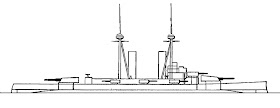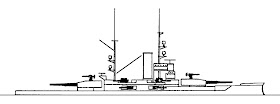During the early 1920s, the Reichsmarine began thinking about the ships they might build when the time came to replace their fleet's old pre-dreadnought battleships. Design work began in 1923, but stopped when the German economy collapsed in 1924. Admiral Hans Zenker, the commander in chief of the Reichsmarine, ordered work to recommence at the earliest opportunity, and in 1925 three new proposed designs were added to the two that had been prepared in 1923.
The 1923 designs were designated I/10 (which was a 32-knot cruiser armed with eight 20.5cm/8-inch guns) and II/10 (which was a 22-knot, heavily armored ship armed with four 38cm/15-inch guns). The 1925 designs were designated II/30, IV/30, and V/30 and were all armed with six 30cm/12-inch guns. The later designs were differentiated from each other by their top speed and level of armour protection. What became known as the Deutschland-class Panzerschiffe or 'pocket battleship' evolved from the 1925 designs, although the main armament was reduced in calibre to 11-inch guns in order to avoid provoking an adverse reaction from the allies. (The Versailles Treaty did not stipulate any limit on the calibre of the main armament carried by the new ships, but it was felt that it was advisable to keep to the calibre carried by the pre-dreadnoughts that were being replaced.)
So what would the II/10 monitor/coastal battleship have looked alike?
The design was very similar that of the Sverige-class Swedish coastal defence battleships ...
The 1923 designs were designated I/10 (which was a 32-knot cruiser armed with eight 20.5cm/8-inch guns) and II/10 (which was a 22-knot, heavily armored ship armed with four 38cm/15-inch guns). The 1925 designs were designated II/30, IV/30, and V/30 and were all armed with six 30cm/12-inch guns. The later designs were differentiated from each other by their top speed and level of armour protection. What became known as the Deutschland-class Panzerschiffe or 'pocket battleship' evolved from the 1925 designs, although the main armament was reduced in calibre to 11-inch guns in order to avoid provoking an adverse reaction from the allies. (The Versailles Treaty did not stipulate any limit on the calibre of the main armament carried by the new ships, but it was felt that it was advisable to keep to the calibre carried by the pre-dreadnoughts that were being replaced.)
So what would the II/10 monitor/coastal battleship have looked alike?
The design was very similar that of the Sverige-class Swedish coastal defence battleships ...
The Sverige-class coastal defence battleships as originally designed.
... and of the Danish Niels Juel as originally designed.The Sverige-class coastal defence battleship Gustav V as modernised during the late 1920s.
The coastal defence battleship Niels Juel as originally designed. She was completed as a training cruiser to a heavily revised design.




I always find it astonishing how much armour and armament is squeezed into such small displacements. There must be some very big - and probably operationally significant - compromises involved, but articles on sites such as Wikipedia rarely seem to cover such limitations.
ReplyDeleteThe main impact is on fuel storage, other stores (food, ammo etc) and crew comfort. There was a reason cruisers were so huge.
DeleteDesigning spaceships in GDWs Traveller expansion 'High Guard' gave me a very good feel for the constraints placed on ship designers!
Mike Hall,
DeleteWarship design is a constant battle between competing factors, such as armament vs. armour vs. engine power/speed vs. range vs. tonnage limitations. In satisfying one, another may need to be compromised.
There are some excellent books about these aspects of warship design, and I really ought to write a blog post about them one day.
All the best,
Bob
Martin Rapier,
DeleteOne reason why the High Seas Fleet battleships often housed its ships' crews in barracks was due in part to the greater internal subdivision the ships had when compared to RN ships. This made the German ships less prone to flooding due to battle damage, but resulted in worse living conditions for the crews if they had to stay aboard for any length of time.
All the best,
Bob
I've always liked the design of the Siamese 1930s 'pocket cruisers' Sri Ayuthia and her sister. Model Boats had a model plan for an 18inch version at one time.
ReplyDeleteJoppy,
DeleteI totally agree. The Japanese designers produced a very balanced design, and much better than the cruiser/coastal defence ships they designed for the Manchukuo government.
All the best,
Bob